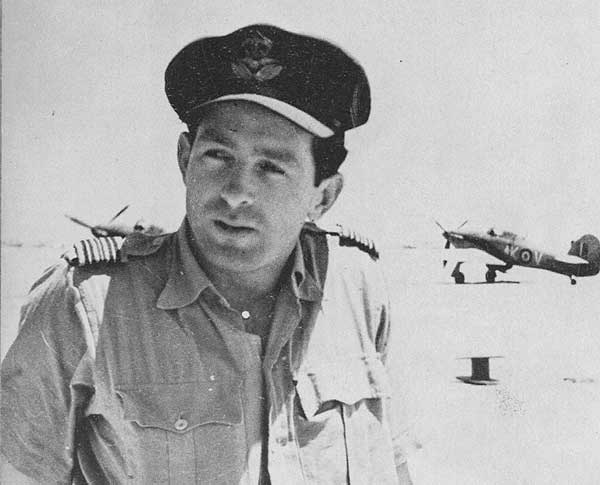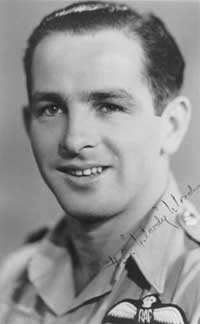
RAF
W/C - DFC & Bar
__________________________________________________________
Woody, as he was known to everyone, was born in Victoria, British Columbia,
Canada in 1916. He joined the Royal Air Force prior to World War II.
He had always wanted to fly but couldn't be accepted for pilot training
in the Royal Canadian Air Force at the time because he didn't have a
University degree. So, like many other Canadians, in 1938 he made his
way to England and joined the R.A.F.
In May 1939, Woody was posted to 33 Squadron in Egypt flying Gladiators.
Although Gazetted in May 1941, his many early successes in North Africa
between June and December of 1940 resulted in the award of the Distinguished
Flying Cross. He moved with the squadron, now flying Hurricanes, to
Greece in February 1941 and then to Crete in May as a flight commander.
After the German invasion of Crete and the fierce fighting that followed,
Woody had to evacuate on foot across the island narrowly avoiding capture.
33 Squadron had effectively been destroyed on Crete but it reformed
in June. He remained with the squadron until he was "tour expired"
in September 1941 and posted to Rhodesia as a flying instructor. In
January 1943 he returned to Egypt to take command of 213 Squadron (Hurricane
IIC). He was awarded the Bar to his D.F.C. in August 1943 in recognition
of his work in Greece two years earlier. Shortly afterwards he attended
the Staff College in Haifa. He was promoted to Wing Commander in June
1944 and in April 1945 he took command of the Middle East Communications
Squadron flying Dakotas and other transport aircraft.
Christopher Shores and Clive Williams record Woody's combat record as
"18 and 4 shared destroyed, 2 unconfirmed destroyed, 3 probable's,
11 damaged" in their book Aces High: A Tribute to the Most Notable
Fighter Pilots of the British and Commonwealth Forces in WW II.
His coolness under fire had earned him the title of "The Imperturbable
Woody" and, tied with S/L H.W. McLeod, DSO, DFC*, was Canada's
second highest scoring pilot of the war.
Woody returned to the UK in November 1945 and decided to remain in the
R.A.F. upon being granted an extended service Commission as a Squadron
Leader. 3 years later he was awarded a Permanent Commission. Woody's
peace time career included various administrative and instructional
postings but he also served many hours on flying duties. In August 1949
he commanded 19 Squadron flying Hornets. In August 1956, he went to
Germany as the commanding officer of 322 Wing flying Hunters. In 1958
he moved to 69 (PR) Squadron as the commanding officer flying Canberra's.
69 Squadron moved from Germany to Malta and later was renumbered as
39 Squadron. In late 1959 he went to the Ministry of Aviation and then
he retired from the Royal Air Force in 1963 after having logged over
3300 hours of flying time.
After moving to Australia, Woody formed a prosperous air charter company.
Then, in August 1967, he returned to British Columbia to setup a business
which, unfortunately, was not successful. Afterwards, while living in
his home town of Victoria, he served in the Corps of Commissionaires
until retirement. In his senior years Woody's passion was Jazz music.
Vernon "Woody" Woodward passed away on May 26, 2000.
See H.A. Halliday, Woody: A Fighter Pilot's Album, published by Canav
Books
_________________________________________________________________
Born in Victoria, British
Columbia, 22 December 1916
educated there
Enlisted in RAF, June 1938
Appointed Acting Pilot Officer on Probation, 20 August 1938
Confirmed as Pilot Officer, June 1939
Flying Officer, September 1940
Died in Victoria, British Columbia, 26 May 2000.
Lengthy obituary in National
Post dated 26 July 2000 which noted that, after his retirement
from the Corps of Commissionaires (1990), he was "a familiar
figure speeding along the winding lanes of the Saanich Peninsula
in his black Jenzen or burgundy Jaguar" but that his license
had been suspended in 1995. |
_________________________________________________________________
First Desert
Victory
When Italy declared war on June 10, 1940, the Royal Air Force only possessed
75 fighters (Gladiators) in the North African theatre. The first Hurricane
squadron would not be formed until August. In the meantime, the nearly
obsolete Gladiators would prove themselves in the classic art of dog
fighting against the similarly equipped Regia Aeronautica.
On June 14, 1940, Woody claimed "One C.A. 310 confirmed destroyed
(Flames) over Fort Cappuzzo. One C.R. 32 probable." in his logbook.
Hugh Halliday, in his book Woody: A Fighter Pilot's Album, describes
the morning as follows:
"No.
33 was flying patrols from dawn of the fourteenth onwards. Four
pilots - F/Os E.H. Dean and R.A. Couchman, P/Os Woodward and A.R.
Costello - were off from Sidi Barrani at 0735 hours, returning at
0925. The ORB described the trip tersely: 'Successful low flying
attack carried out on a Ghibli bomber on ground at Sidi Aziez.'
The disabled machine was later captured by advancing British troops.
Thirty-five minutes after landing, barely enough time
for a coffee while the Gladiators were refueled and rearmed, Dean
and Woodward were off again. A few minutes later Sgt Craig followed.
The squadron ORB described what happened: 'One Caproni 310 shot
down by Pilot Officer V.C. Woodward and Sergeant Craig, both over
Capuzzo.'
This combat, resulting in the RAF's first aerial
victories in North Africa, has since been the subject of
varying accounts. Christopher Shores, in Fighters Over the Desert,
states that the Gladiators intercepted several twin-engine Ca.310
reconnaissance bombers under CR.32 fighter escort and mentions three
victories -- a CR.32 shot down by Dean, a Ca.310 downed by Woodward,
plus a CR.32 probably destroyed by Woody.
Another
writer, J.D.R. Rawlings, reports in Air Pictorial,
September 1970 that the Gladiators met a single Ca.310 and
three CR.32s over Fort Capuzzo, repeats that Dean shot down
a CR.32, and confirms that Woodward and Craig shared a Caproni;
Rawlings does not mention Woodward's probable CR.32. Woody
himself lists the 'probable' in a victory tally jotted down
in his second logbook; he recalls meeting the Capronis at
the same altitude as the Gladiators, and that as he attacked
one he aimed for the engines. When a motor began smoking,
the Italian crew crash-landed among British tanks near Fort
Capuzzo. During the battle a single bullet had missed his
head by inches -- the hole was visible through one wing."
Although the accounts above vary in detail, in later research,
Shores and Williams help confirm Woody's original claim in
their 1994 edition of Aces High with the following
notes: "Ca310 of 159ª Squadriglia, 12 Gruppoº,
crash-landed; Serg Azzarane in CR32 of 8 Gruppoº CT shot
down and killed". |

Woody Woodward
|
______________________________________________________
WOODWARD, F/L Vernon Crompton
(41092) - Distinguished Flying Cross
Awarded as per London Gazette dated 9 May 1941 &
Specifically listed in AFRO 1292/41
dated 7 November 1941 as a
Canadian in the RAF who had been decorated as of that date.
Air Ministry Bulletin
3827 refers; no citation in London Gazette other than "for
gallantry and devotion to duty in the execution of air operations".
Public Records Office Air 2/9532 has recommendation sent on 18
April 1941 from RAFHQ Middle East to Air Ministry; rank stated
as Flying Officer;
Recommended for his outstanding
courage and devotion to duty on each of his frequent engagements
with the enemy. He attacks the enemy with such determination and
vigour that he invariably concludes the engagement with a confirmed
victory. His fighting spirit and keenness has an excellent effect
on all pilots in the squadron, and to date he has destroyed eleven
enemy aircraft and probably one other.
This was further refined
for Air Ministry Honours and Awards Committee:
This officer has displayed
outstanding courage in his many engagements against the enemy.
His attacks are pressed home with such determination and vigour
that he invariably concludes with a confirmed victory. He has
destroyed at least eleven enemy aircraft, and his fighting spirit
and keenness have set a splendid example.
_________________________________________________
WOODWARD, S/L Vernon Crompton
(41092) - Bar to Distinguished Flying Cross
Awarded as per London Gazette dated 6 August 1943 &
AFRO 1949/43 dated 24 September 1943 which also described him
as a
"Canadian in the RAF." Air Ministry Bulletin 11042 refers:
Since the award of the
Distinguished Flying Cross in April 1941, this officer has destroyed
nine enemy aircraft, bringing his total victories to twenty. Squadron
Leader Woodward has a fine record of achievement, displaying at
all times outstanding courage and devotion to duty.
|
______________________________________________________
|

